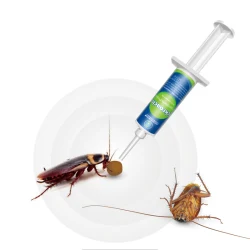Here are some common types of pest control products
2023-12-18
Pest control products are substances or devices designed to manage, prevent, or eliminate unwanted pests such as insects, rodents, and other organisms that can be harmful to human health, agriculture, or property. These products are available in various forms, including pesticides, traps, repellents, and biological control agents. Here are some common types of pest control products:
1. Insecticides:
- Chemical Type: Insecticides are chemicals designed to kill or control insects.
- Usage: Sprays, powders, baits, and foggers are commonly used to control insect pests such as mosquitoes, ants, roaches, and flies.
2. Rodenticides:
- Chemical Type: Rodenticides are chemicals formulated to control rodents, including rats and mice.
- Usage: Baits, pellets, and blocks containing rodenticides are used to address rodent infestations.
3. Repellents:
- Chemical Type: Repellents are substances that deter pests without necessarily killing them.
- Usage: Repellent sprays, lotions, and devices are used to keep insects like mosquitoes or ticks away from humans and animals.
4. Traps:
- Mechanical Type: Traps capture and contain pests without using chemicals.
- Usage: Various types of traps include snap traps for rodents, glue traps for insects, and live traps for humane capture and release.
5. Biological Control Agents:
- Natural Predators or Parasites: These are living organisms that control pests by preying on or parasitizing them.
- Usage: Ladybugs, predatory mites, and parasitic wasps are examples of biological control agents used in integrated pest management (IPM) approaches.
6. Insect Growth Regulators (IGRs):
- Chemical Type: IGRs disrupt the life cycle of insects, inhibiting their growth and development.
- Usage: IGRs are often used in insecticide formulations to control pests like fleas and mosquitoes.
7. Fumigants:
- Chemical Type: Fumigants are chemicals that produce gas or vapor to control pests in enclosed spaces.
- Usage: Fumigation is commonly used in the control of stored product pests and certain structural pests.
8. Nematodes:
- Biological Control Agent: Nematodes are microscopic roundworms that parasitize and kill certain soil-dwelling pests.
- Usage: Applied to the soil, nematodes are used to control pests like grubs and larvae.
9. Insecticidal Soaps and Oils:
- Chemical Type: These products use soap or oil formulations to suffocate or disrupt the cellular membranes of certain pests.
- Usage: Effective against soft-bodied insects such as aphids, mites, and whiteflies.
10. Ultrasonic Repellent Devices:
- Electronic Type: Devices emitting ultrasonic sounds are marketed to repel pests.
- Usage: These devices claim to deter pests like rodents and insects by emitting high-frequency sounds.
11. Pheromone Traps:
- Chemical Type: Pheromone traps use synthetic versions of insect sex pheromones to attract and trap pests.
- Usage: Effective in monitoring and controlling certain insect pests by disrupting their mating patterns.
12. Baits and Attractants:
- Chemical or Food Type: Baits use attractants, often combined with pesticides, to lure pests to a specific location.
- Usage: Used in rodent baits, ant baits, and other targeted pest control applications.
It's important to use pest control products responsibly and according to labeled instructions. Integrated pest management (IPM) approaches, which combine multiple methods for sustainable pest control, are increasingly emphasized to minimize environmental impact and reduce reliance on chemical treatments alone. Before using any pest control product, it's advisable to consult with professionals or follow guidelines provided by relevant authorities to ensure effective and safe pest management practices.



